
- •Sequence Diagram
- •Basic examples
- •Comments
- •Declaring participant
- •Use non-letters in participants
- •Message to Self
- •Change arrow style
- •Change arrow color
- •Message sequence numbering
- •Title
- •Legend the diagram
- •Splitting diagrams
- •Grouping message
- •Notes on messages
- •Some other notes
- •Changing notes shape
- •Creole and HTML
- •Divider
- •Reference
- •Delay
- •Space
- •Lifeline Activation and Destruction
- •Participant creation
- •Incoming and outgoing messages
- •Stereotypes and Spots
- •More information on titles
- •Participants encompass
- •Removing Footer
- •Skinparam
- •Use Case Diagram
- •Usecases
- •Actors
- •Usecases description
- •Basic example
- •Extension
- •Using notes
- •Stereotypes
- •Changing arrows direction
- •Title the diagram
- •Splitting diagrams
- •Left to right direction
- •Skinparam
- •Complete example
- •Class Diagram
- •Relations between classes
- •Label on relations
- •Adding methods
- •Abstract and Static
- •Advanced class body
- •Notes and stereotypes
- •More on notes
- •Note on links
- •Abstract class and interface
- •Using non-letters
- •Hide attributes, methods...
- •Hide classes
- •Use generics
- •Packages
- •Packages style
- •Namespaces
- •Automatic namespace creation
- •Lollipop interface
- •Changing arrows direction
- •Title the diagram
- •Legend the diagram
- •Association classes
- •Skinparam
- •Skinned Stereotypes
- •Color gradient
- •Activity Diagram
- •Simple Activity
- •Label on arrows
- •Changing arrow direction
- •Branches
- •More on Branches
- •Synchronization
- •Long activity description
- •Notes
- •Partition
- •Title the diagram
- •Skinparam
- •Octagon
- •Complete example
- •Activity Diagram (beta)
- •Simple Activity
- •Start/Stop
- •Conditional
- •Repeat loop
- •While loop
- •Parallel processing
- •Notes
- •Title Legend
- •Colors
- •Arrows
- •Grouping
- •Swimlanes
- •Detach
- •Complete example
- •Component Diagram
- •Components
- •Interfaces
- •Basic example
- •Using notes
- •Grouping Components
- •Changing arrows direction
- •Title the diagram
- •Use UML2 notation
- •Skinparam
- •State Diagram
- •Simple State
- •Composite state
- •Long name
- •Concurrent state
- •Arrow direction
- •Note
- •More in notes
- •Skinparam
- •Object Diagram
- •Relations between objects
- •Common features with class diagrams
- •Common commands
- •Footer and header
- •Zoom
- •Salt
- •Basic widgets
- •Using grid
- •Using separator
- •Tree widget
- •Enclosing brackets
- •Adding tabs
- •Using menu
- •Advanced table
- •Creole
- •Emphasized text
- •List
- •Escape character
- •Horizontal lines
- •Headings
- •Legacy HTML
- •Table
- •OpenIconic
- •Encoding Sprite
- •Importing Sprite
- •Examples
- •Changing fonts and colors
- •Usage
- •Nested
- •Color
- •Font color, name and size
- •Black and White
- •Preprocessing
- •Including URL
- •Macro on several lines
- •Conditions
- •Search path
- •Advanced features
- •Internationalization
- •Charset
- •Color Names
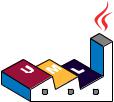
Drawing UML with PlantUML
Language Reference Guide
(Version 8020)
PlantUML is an Open Source project that allows to quickly write:
•Sequence diagram,
•Usecase diagram,
•Class diagram,
•Activity diagram,
•Component diagram,
•State diagram,
•Object diagram.
Diagrams are defined using a simple and intuitive language.
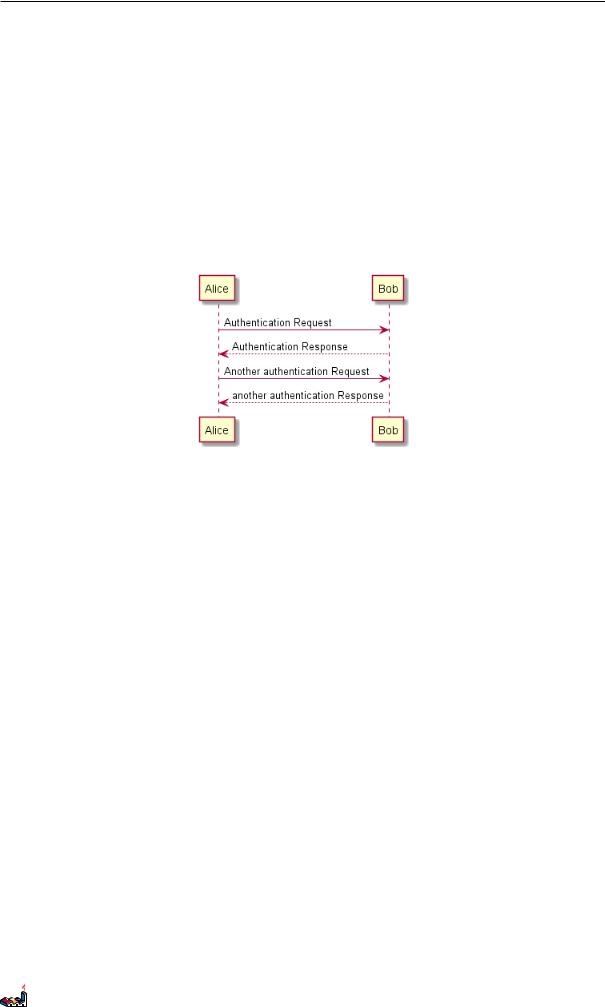
1 SEQUENCE DIAGRAM
1 Sequence Diagram
1.1 Basic examples
The sequence "->" is used to draw a message between two participants. Participants do not have to be explicitly declared.
To have a dotted arrow, you use -->
It is also possible to use <- and <--. That does not change the drawing, but may improve readability.
@startuml
Alice -> Bob: Authentication Request Bob --> Alice: Authentication Response
Alice -> Bob: Another authentication Request Alice <-- Bob: another authentication Response @enduml
1.2 Comments
Everything that starts with simple quote ' is a comment.
You can also put comments on several lines using /' to start and '/ to end.
1.3 Declaring participant
It is possible to change participant order using the participant keyword.
It is also possible to use other keywords to declare a participant:
•actor
•boundary
•control
•entity
•database
@startuml actor Foo1 boundary Foo2 control Foo3 entity Foo4 database Foo5
Foo1 -> Foo2 : To boundary Foo1 -> Foo3 : To control Foo1 -> Foo4 : To entity Foo1 -> Foo5 : To database
@enduml
PlantUML Language Reference Guide (Version 8020) |
1 of 118 |
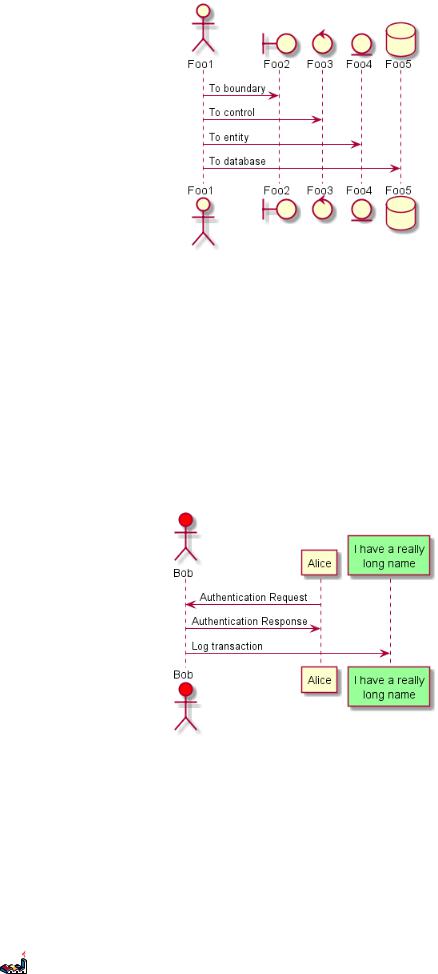
1.4 Use non-letters in participants |
1 SEQUENCE DIAGRAM |
You can rename a participant using the as keyword.
You can also change the background color of actor or participant.
@startuml actor Bob #red
' The only difference between actor 'and participant is the drawing participant Alice
participant "I have a really\nlong name" as L #99FF99 /' You can also declare:
participant L as "I have a really\nlong name" #99FF99 '/
Alice ->Bob: Authentication Request Bob ->Alice: Authentication Response Bob ->L: Log transaction
@enduml
1.4 Use non-letters in participants
You can use quotes to define participants. And you can use the as keyword to give an alias to those participants.
@startuml
Alice -> "Bob()" : Hello
"Bob()" -> "This is very\nlong" as Long
'You can also declare:
'"Bob()" -> Long as "This is very\nlong" Long --> "Bob()" : ok
@enduml
PlantUML Language Reference Guide (Version 8020) |
2 of 118 |
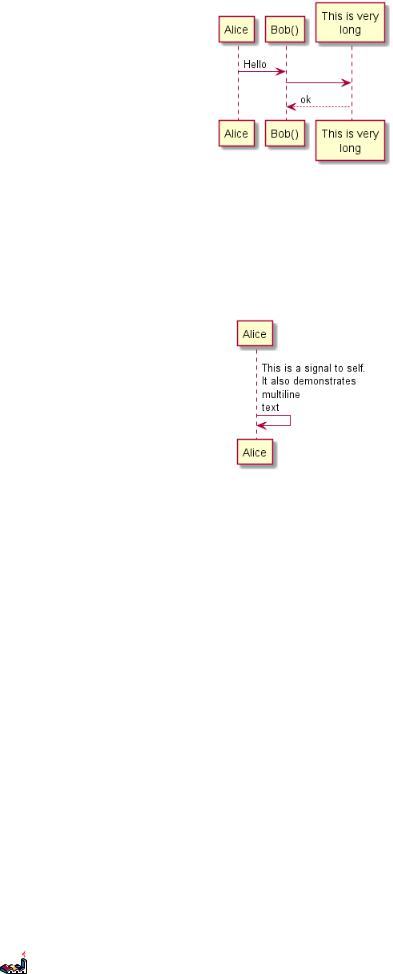
1.5 Message to Self |
1 SEQUENCE DIAGRAM |
1.5 Message to Self
A participant can send a message to itself.
It is also possible to have multi-line using \n.
@startuml
Alice ->Alice: This is a signal to self.\nIt also demonstrates\nmultiline \ntext @enduml
1.6 Change arrow style
You can change arrow style by several ways:
•add a final x to denote a lost message
•use \ or / instead of < or > to have only the bottom or top part of the arrow
•repeat the arrow head (for example, >> or //) head to have a thin drawing
•use -- instead of - to have a dotted arrow
•add a final ”o” at arrow head
•use bidirectional arrow
@startuml
Bob ->x Alice Bob -> Alice Bob ->> Alice Bob -\ Alice Bob \\- Alice Bob //-- Alice
Bob ->o Alice
Bob o\\-- Alice
Bob <-> Alice
Bob <->o Alice
@enduml
PlantUML Language Reference Guide (Version 8020) |
3 of 118 |
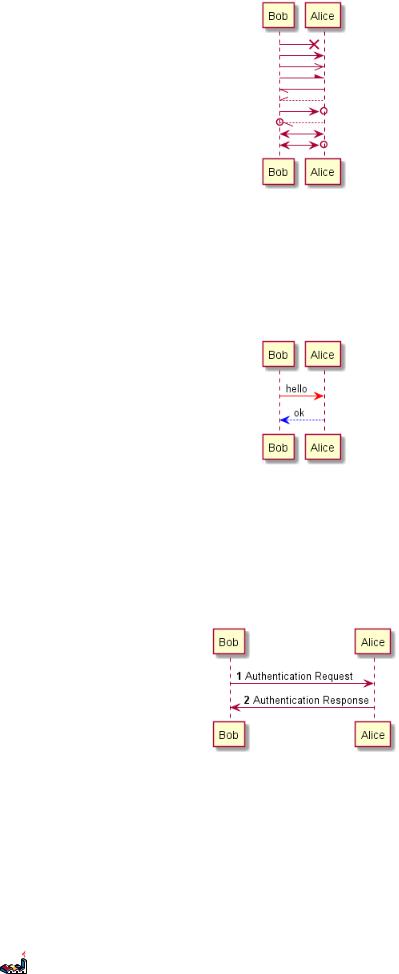
1.7 Change arrow color |
1 SEQUENCE DIAGRAM |
1.7 Change arrow color
You can change the color of individual arrows using the following notation:
@startuml
Bob -[#red]> Alice : hello Alice -[#0000FF]->Bob : ok @enduml
1.8 Message sequence numbering
The keyword autonumber is used to automatically add number to messages.
@startuml autonumber
Bob -> Alice : Authentication Request Bob <- Alice : Authentication Response @enduml
You can specify a startnumber with autonumber 'start' , and also an increment with autonumber 'start' 'increment'.
@startuml autonumber
Bob -> Alice : Authentication Request Bob <- Alice : Authentication Response
autonumber 15
Bob -> Alice : Another authentication Request Bob <- Alice : Another authentication Response
autonumber 40 10
PlantUML Language Reference Guide (Version 8020) |
4 of 118 |
